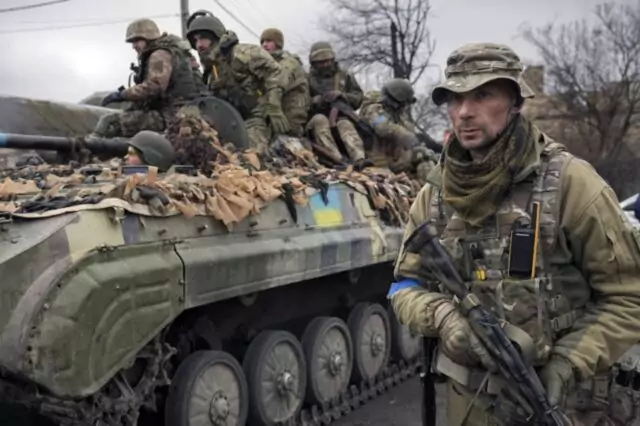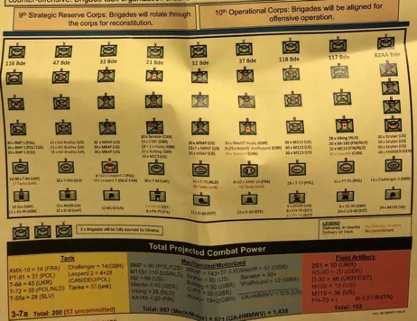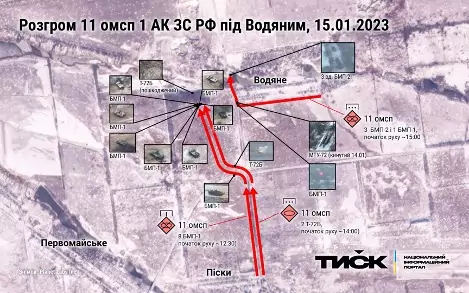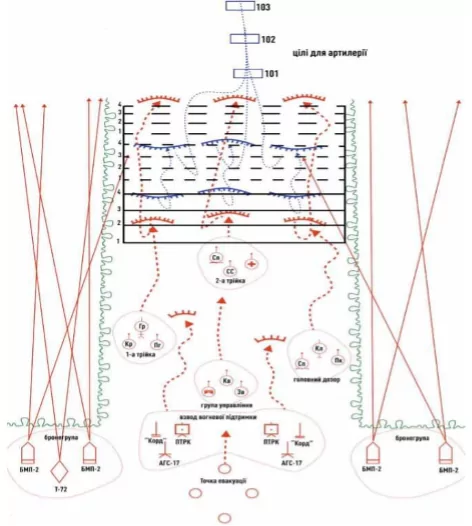Hlib Parfonov

Executive Summary:
- Delays in weapons deliveries, disproportionate political pressure, and problems with command, control, and communications plagued Ukraine’s 2023 counteroffensive from the start.
- Ukrainian forces’ ability to wage a successful 2024 campaign largely rests on Kyiv’s efforts to mobilize more military-age men to reinforce the frontlines as well as the timely and sufficient supply of Western aid.
- In 2024, Ukraine will need more support for maintaining—or in some cases attaining—relative parity with Russian airpower, manpower, and firepower.
- Ukraine analyzed Russian operations around Soledar, Bakhmut, and Vuhledar to inform defensive fortifications and preparations for future counteroffensives, gaining a better understanding of Russia’s use of small infantry groups and light arms.
- Analysis of the 2023 counteroffensive revealed that Ukraine’s military leaders failed to adjust their goals in accordance with shortages in armored vehicles, long-range capabilities, demining equipment, and personnel.
- Recent reports that Moscow is signaling to the West that it is open to negotiations is nothing more than a Kremlin campaign to sow discord and weaken the resolve of Ukraine’s Western partners.
- The Kremlin continues to build up its forces in Ukraine with the intention to launch future offensives, as the total number of Russian soldiers on Ukrainian territory has increased by almost 100,000 since May 2023.
The two-year mark of Russia’s full-scale invasion of Ukraine is fast approaching. Ukraine’s counteroffensive has stalled in the south. Russia has seemingly retaken the initiative on the battlefield, launching a series of offensive operations in the Avdiivka, Kupyansk, Bakhmut, and Mariinka directions that have resulted in heavy casualties (Ukrinform, December 14). Ukrainian forces, nevertheless, continue to make progress in the Black Sea, with a series of successful drone attacks on the Russian Black Sea Fleet’s Sevastopol headquarters and sinking more than 20 Russian naval vessels (see EDM, September 26, November 15, 2023, January 17; Kyiv Independent, December 28).
Ukraine has also enjoyed some gains in and around the Dnipro River, though that advance has also stalled in the face of continuous Russian counterattacks. As Moscow did with Ukraine’s successful 2022 counteroffensive, Kyiv learned much from its stalled 2023 counteroffensive and has restructured its forces and overall strategy in preparation for this year’s campaign. The success of that prospective campaign will rest on timely and sufficient supply of war matériel, including long-range weapons, by Ukraine’s Western allies and overcoming the long-standing problems with command, control, and communications (C3), as well as personnel training.
The Russian Armed Forces learned much from Ukraine’s counteroffensive in September 2022 and have since reorganized and reinforced defensive lines based on those lessons (see EDM, August 8, 15, 2023, September 6, 26, 2023, October 4, 2023). The slowness and inconsistency of Western aid gave the Russian side ample time to prepare for Ukraine’s much-anticipated counteroffensive last year. That, coupled with political pressure on Kyiv, doomed the counteroffensive almost from the start. With the winter campaign underway, examining what went wrong in 2023 and what needs to change for Ukraine to make a serious breakthrough in 2024 is critical. Kyiv seeks solutions in mobilizing more military-age men to reinforce the frontlines and growing “Ukraine fatigue” in the West has hurt prospects for future aid. The inability of Ukraine’s Western partners to provide adequate equipment and munitions will hamper the Ukrainian Armed Forces’ ability to wage a successful campaign in 2024.
Ukrainian Military Analysis of Russian Offensives
Soledar Operation
Preparations for Ukraine’s 2023 counteroffensive began at the end of 2022. At that time, the Battle of Bakhmut was still raging, and Kyiv was increasing measures to mobilize more conscripts (see EDM, January 17, February 15, April 17, July 26, 2023). With Russian strike forces tied down and significantly depleted, Ukraine’s military leadership began organizing brigades for the next counteroffensive (see EDM, March 29, July 26). Those preparations came with several difficulties. For example, the figure below depicts the planned equipment for the 9th and 10th Army Corps for the counteroffensive.

Many brigades did not have sufficient modernized armored vehicles, and many had only mine resistant ambush protected vehicles (MRAPs) for infantry that could not sustain a mechanized offensive. This underscores the lingering problems of delays in Western aid and an insufficient supply of more modern military supplies and munitions. Specifically, the severe lack of demining equipment coupled with the Ukrainian military leadership’s inability to correlate its goals with resources on hand and the balance of quality and quantity of its forces undermined the 2023 counteroffensive (Radio Free Europe/Radio Liberty, May 24, 2022; see EDM, February 21, 2023).
Decisions on the planned staffing for the 2023 counteroffensive began to come together during the Russian Soledar operation in January and February. Ukrainian forces examined the successes and failures of Russia’s concentrated offensive operations, presenting conclusions to inform tactics for their own counteroffensive. Further analysis of these conclusions in “Experience of Conducting Combat Operations by Russian Military Formations in the Operational Area of the Tactical Group ‘SOLEDAR’ (1 January–28 February, 2023)” reveals which tactics were ultimately correct and incorrect in Kyiv’s planning (Ministry of Defense of Ukraine, accessed January 2).
Ukrainian analysis examined Russia’s force structure in carrying out the operation. According to this analysis, the tactics of the Russian armored formations were generally focused on “gnawing or pushing” through the well-prepared Ukrainian defense. Around Soledar, Russia’s armored vehicles advanced slowly and were periodically destroyed by Ukraine’s anti-tank units. As a result, the Russian army switched to small-unit tactics to “squeeze” Ukrainian units by systematically advancing from house to house and street to street. In populated areas, Russian units mainly operated in small assault groups of three to 15 people, occasionally using a platoon of up to 30 people. They were usually armed with small arms, with only a few carrying 82-millimeter mortars and anti-tank guided missiles. The switch to smaller units and lighter firepower marked a significant shift in Russian strategy.
Ukrainian military analysts also noticed that Russian assault operations tended not to be conducted along the frontlines. Alternatively, these operations targeted the right and left flanks, using dense forest lines to shield maneuvers. This allowed assault groups to covertly approach Ukrainian positions and penetrate the junctions between units. Russian formations carried out multiple assaults simultaneously to distract Ukrainian units in different directions and disperse their firepower. The same tactics were used to mislead Ukrainian forces about the intended nature and direction of Russian offensive operations, particularly to provoke “friendly fire” and create the impression that neighboring positions have already been captured.
An important insight highlighted Russia’s use of automatic easel-mounted grenade launchers (AGS-17), which caused the loss of 50 percent of Ukrainian units in this area. These weapons were shot from closed firing positions at previously identified targets, mainly Ukrainian personnel units located at checkpoints or rollover protective structures. The Russians followed a consistent step-by-step process in using these weapons. First, a group of five to seven AGS units would come together with a drone-operating unit. Drones would then conduct reconnaissance of Ukrainian units and transmit their coordinates back to the AGS units. With additional surveillance, the AGS units would begin work on pinpointing the target’s coordinates. Once the coordinates were established, some of the AGS units would continue firing in turn, while the others reloaded. This ensured a continuity and high density of fire. The Wagner Group primarily used this method to quickly capture some Ukrainian positions without heavy artillery.
The Battles for Bakhmut and Vuhledar
Ukrainian military analysts identified key aspects of the failed Russian operations in the Bakhmut and Vuhledar directions to better prepare for future offensives. The battles for Bakhmut and Vuhledar showed that Ukraine’s awareness and preparation in advance of Russian actions made it possible to fully thwart an offensive operation, devising the contour of countermeasures from available forces and means.
Russian troops conducted “human wave” assaults in the first stage of the Bakhmut offensive largely because of the impossibility of carrying out offensive operations by other means. This allowed the Ukrainian side to prepare assault groups to push back Russian forces. For example, as depicted in the figure below, the attacking group of Russia’s 11th “Vostok” Separate Guards Motorized Rifle Regiment was defeated in this way (Telegra.ph, January 29,
2023).

The actions of Russian assault units in the Vuhledar direction were in accordance with a relatively new regulation at the time, namely “Specifics of Conducting Combat Operations in a Settlement (City) and Forest Protection Zone as Part of an Assault Unit (Company, Platoon)” (Nvkarta.com, accessed January 2). According to the regulation, when operating in a forested area, Russian forces will use a “rhombus” formation, with an assault troop manning each vertex. They use closed and open communication channels during operations, with each soldier required to have a radio to communicate with the platoon commander. Each vehicle in the armored group also has an open communication channel. Russia uses its own version of street names and addresses in the settlement under attack to confuse the defenders. The new approach emphasizes that unmanned aerial vehicles (UAVs) should be used only for reconnaissance. These UAVs are available at the platoon level, and their operators report directly to the platoon commander. Having a better understanding of this strategy, the Ukrainian side could jam communications and restructure defensive positions accordingly.
The Russian approach is reminiscent of the mechanized units used by Nazi Germany’s Wehrmacht in World War II. As outlined in the book Combat Instruction for the Panzer Grenadier (Helmut von Wehren, Gefechtsausbildung der Panzergrenadiere, Offene Worte: Berlin, 1944):
The armored section is tasked with protecting the following elements (platoon, company) from surprise attack, removing obstacles, breaking down weaker resistance, and ensuring unimpeded advance. When encountering the enemy, it provides the platoon or company a basis for security and reconnaissance. … When under attack by armor-piercing weapons, the squad leader must decide whether he will drive to the nearest shelter with the entire squad, possibly by blowing smoke from the BMP [armored personnel carrier] and dismounting to act, or quickly separate the squad from the BMP by ordering it to dismount immediately. The latter usually occurs if the BMP is directly under enemy anti-tank gunfire and moving to the next cover takes longer than dismounting. The dismounted unit immediately observes the enemy.

Lessons Learned for Future Counteroffensives
The Ukrainian military’s analysis of Russian operations has led to several keen insights. For example, during the Vuhledar offensive, Russian units were decimated by Ukraine’s extensive minefields and heavily fortified defensive positions. The experience demonstrated that, when remote mining and defensive re-posturing take place well in advance, a military offensive can be stopped in its tracks, resulting in heavy losses for the attacking side. This success was largely thanks to the concept of intelligence, surveillance, target acquisition, and reconnaissance (ISTAR) network-centric operations. In 2010, the Defense Select Committee of the UK House of Commons Defense called this concept “the heart of operational effectiveness, maximizing force and concentrating the capabilities of existing assets. … ISTAR will be the center of battlefield dominance for the foreseeable future” (UK Parliament, September 2, 2010). In the years before Russia’s full-scale invasion of Ukraine, a series of Ukrainian authors analyzed the country’s ISTAR approach, emphasizing the critical need for wider implementation of the concept throughout the armed forces (Collection of the Scientific Papers of the Centre for Military and Strategic Studies of the National Defence University of Ukraine, February 26, 2018).
The Bakhmut offensive showed the possibility of pushing through enemy positions with small infantry groups and lighter arms, similar to the experience of the Wehrmacht’s assault platoons. Unlike the German experience, the Russian Armed Forces have relied on numerical superiority in conducting “human wave” assaults. Seeing the Battle of Bakhmut as a Materialschlacht (material battle), an approach in which the military command spends available reserves to wear down the enemy, Moscow adopted the tactic of exhausting Ukrainian defensive positions with constant attacks. Due to understaffed and inadequately equipped reserve units, Ukraine’s defensive lines eventually broke down in some areas, allowing the Russians to take Soledar and the territory north of Bakhmut. This ultimately demonstrated that the Russian side can afford heavier losses in manpower and weapons systems than the Ukrainian side can, though huge losses have stunted Moscow’s more recent offensive operations.
Ukraine avoided a similar fate in pulling back some of its units when the 2023 counteroffensive began to stall. That decision was made after Russia’s destruction of the Kakhovka Hydroelectric Power Plant in June and fighting in the south was becoming increasingly positional (see EDM, June 19, 28, 2023). The leveling of forces allowed Ukraine to retain some of its potential for future counteroffensives. This posturing also disproportionately pulled Russian troops to Ukraine’s south until Moscow began to relocate units to Avdiivka and other regions.
After Ukraine’s counteroffensive stalled, the Russians launched a new offensive in the Avdiivka direction (see EDM, October 24, 2023; January 16). According to available data, more than 12 motorized infantry brigades with complimentary tank regiments and separate infantry battalions are fighting in the Avdiivka area. Although the Russians learned much from the fighting over the past year, they have struggled to achieve any real results in the current offensive. The Russian army has been fighting here for over two months, with only partial success to the north and south of Avdiivka. Despite the heavy losses incurred in the Avdiivka, Bakhmut, Kupyansk and Lymansk areas, Russia continues to build up its grouping of forces in the occupied territories and in the adjacent Russian regions that are considered part of the so-called “special military operation.” At the time of writing, 462,000 Russian soldiers and officers are stationed on Ukrainian territory, as well as about 35,000 Rosgvardia (Russian National Guard) units (Deutsche Welle Ukraine, January 11). The total number of Russian personnel involved in the war is around 520,000. If troops stationed in Russia are included, the total comes to about 550,000 (T.me/smotri_media, January 26). These statistics reveal that Moscow is not only replenishing its losses but also building up its grouping of forces. In May 2023, the number of Russian troops in Ukraine was much smaller—about 370,000 soldiers and officers as well as about 20,000 Rosgvardia units. All this suggests that Moscow is not giving up on its attempts to conduct offensives in Ukraine in 2024 and may be preparing to provoke other countries (ERR, December 12, 2023).
Another lesson learned is that relative parity in Ukraine’s and Russia’s technological capabilities effectively levels the playing field during an offensive. Both sides have used space reconnaissance, electronic warfare, and airborne repeaters to improve their own communications while disrupting the other side’s channels. Although Russia’s communications have been of much lower quality than those of Ukraine for most of the war, the Russians are catching up. The 1st Army Corps has already improved communication between units by installing Sotnyk-BL radios instead of the standard R-168 in T-72B3 models. The newer radios are said to operate in the 400–470 megahertz frequency range and possess a digital mobile radio channel. In general, these capabilities will allow Russian armored personnel crews to seamlessly switch between channels with one another and channels with infantry units (T.me/mag_vodogray, December 10, 2023).
Overall, Ukraine’s analysis of Russian operations has given Kyiv important insights for planning its next counteroffensive. Maintaining technological parity, better management and organization of manpower assets, and the wider implementation of ISTAR strategies will be critical, as well as receiving promised Western aid in a timely manner. The words of Valerii Zaluzhnyi, commander-in-chief of the Ukrainian Armed Forces, sums the situation up quite well:
Preparing an offensive campaign requires the creation of one or more operational (operational-strategic) groups consisting of 10 to 20 combined arms brigades, depending on the intentions and ambitions of the Ukrainian command. Currently, this can only be done by replacing the main models of weapons of the existing brigades with modern ones provided by Ukraine’s partners. Separately, it is necessary to obtain additional missiles and munitions, artillery and missile systems, as well as electronic-warfare equipment from [our] partners. All this will require consolidation of the efforts of all Ukraine’s partner countries for a long time and significant financial expenditures (Ukrinform, November 7, 2022).
Kyiv’s ability to conduct future successful counteroffensives directly depends on the availability of crucial military resources. While Ukraine’s manpower has been incredibly resilient, the same cannot be said for heavy weapons and munitions, especially long-range capabilities. The West must maintain the necessary political will, engage in more thoughtful planning, and fully utilize production capabilities to properly equip the Ukrainian Armed Forces. Supporting Ukraine in its existential fight with Russia will be much cheaper for Western countries than if they took on Moscow directly.
Remaining Problems and Limitations
Ukraine has greatly improved its organization of forces and decision-making approach, but some issues still need to be resolved. For example, the Ukrainian military leadership is constantly working to improve procedures for creating and training reserve units (see EDM, July 26, August 8, 2023). Ukraine has limited capabilities to train reserves on its own territory, as the threat of Russian drone and missile strikes on training grounds looms large (Istorichna Pravda, November 2, 2023). Some Western countries are already training Ukrainian units on their territories, but more is needed (Defense.gov, March 30, June 15, 2023).
Ukrainian forces involved in repelling the Russian offensives along the entire line of contact have faced the problem of overcoming Russia’s manpower and firepower superiority. Moscow has enjoyed this advantage due to outsized air resources, adequate remote-mining and demining equipment, a larger cache of artillery shells, an effective adaptation of electronic-warfare capabilities, and a greater pool of reserves. In 2024, Ukraine will need more support in maintaining, or in some cases attaining, relative parity with Russian resources. The European Union’s ongoing debate on the next aid package and stalled negotiations in Washington will only serve to reduce Ukraine’s operational capacity (see EDM, December 11, 2023; Kyiv Independent, January 12; Ukrainska Pravda, January 22).
The Russian side is not without its own difficulties. Heavy losses on the front limit Moscow’s offensive capabilities. The war is increasingly coming home to Russians, disrupting their everyday lives and leading to increased public discontent (see EDM, November 13, 27, December 7, 21, 2023; January 16, 17, 19, 22). Russian defense production is also struggling to keep up with demands, and import substitution efforts to ameliorate the impact of Western sanctions have been rather ineffective (see EDM, October 5, 31, December 4, 2023; January 16, 22). Additionally, even with relative strategic superiority in military, economic, human, and natural resources, Russian forces are still unable to fully implement the Russian General Staff’s objectives. Counteracting Russia’s offensive operations, nevertheless, remains costly for Ukraine.
2024 Outlook
Positional warfare will likely characterize most of the 2024 campaign. Kyiv is keeping a close eye on whether Russia will call for another wave of mass mobilization after the March elections. Moscow needs to replenish its officer corps and find fresh recruits to throw into the “meat grinder” in Ukraine (see EDM, October 24, 2023, November 3, 2023). In general, the upcoming elections for many of Ukraine’s Western partners have factored into Kyiv’s decision to move toward more positional warfare tactics and prepare for next steps. A moderated war is not a winning war. The prohibitions on Ukraine firing or launching an offensive on Russian territory only plays in Moscow’s favor. The current situation allows the Russian army to concentrate resources and reinforce defensive fortifications, as well as redeploy the necessary forces and equipment to sustain the current offensive.
Significant gaps remain in Ukraine’s military planning. In 2023, Kyiv did not make the necessary moves to alleviate the strain on the military’s manpower. In the fall of 2023, Zaluzhnyi spoke about the increasingly serious situation with depleted personnel. Still, the Ukrainian government did not take the adequate steps to ensure that Ukrainian units were properly replenished (Ukrainian Military Pages, November 27, 2023). Some formations, especially the newly created ones, were forced to go on the offensive with significant staff shortages. The Ukrainian leadership is seemingly trying to switch back to force generation based on unit rotations—an approach forged during the limited-scale operations in Donbas from 2015 to 2021. Despite some advantages, the low-intensity rotation system requires enormous manpower and can put excessive strain on the national economy. In addition to mobilization issues, Russian disinformation campaigns have contributed to the demoralization of Ukrainian society, and corruption scandals in the Defense Ministry have adversely affected public trust in Kyiv (see EDM, July 26, September 18, 2023; Ukrainian Military Pages, November 20, 2023).
The political decisions that have disrupted mobilization will also make implementing a unit rotation system “by the book” exceedingly difficult (Military Review, accessed January 26). Due to struggles with mobilization, it will be near impossible to carry out this approach to rotations. The Ukrainian Armed Forces need more space to carry out successful mobilization efforts, but that all depends on the country’s political leadership.
Differences with Ukraine’s Western partners could exacerbate these issues. Kyiv has been unable to convince the West to grant permission to use supplied weapons or conduct a military operation on Russian territory. The lack of adequate supplies of Army Tactile Missile Systems (ATACMS), cluster munitions, and armored vehicles has been detrimental to the war effort. The West’s attempts to manage escalation during the war have played directly into Moscow’s hands.
All this casts doubts on any real chance for negotiations in 2024 that would account for Kyiv’s interests. Recent reports that Moscow is signaling to the West that it is open to negotiations is nothing more than a Kremlin campaign to sow discord and weaken the resolve of Ukraine’s Western partners (Kyiv Independent; Meduza; The Moscow Times, January 26). It is futile to hope that Russian President Vladimir Putin would be open to an any agreement that requires the full withdrawal of Russian forces from Ukrainian territory, including Crimea (see EDM, May 10, 2023). On the contrary, with upcoming elections and signs of “Ukraine fatigue” in the West, Russia will only increase its pressure, believing in its own strength. Additionally, global instability is growing at an alarming rate with the war in Gaza, Venezuela’s possible invasion of Guyana, China’s provocations against Taiwan, and the recent Houthi missiles strikes in the Red Sea (see China Brief, October 4, November 10, 20, December 1, 15, 2023; EDM, October 16, November 1, 27, December 18, 2023; Terrorism Monitor, December 15, November 17, 2023). These developments give added urgency to a complete Ukrainian victory against Russia. This year will be critical in measuring the West’s resolve to not only support Kyiv until Russian forces are driven from Ukrainian territory but also take the necessary steps to reduce the potential for future global conflicts.


No comments:
Post a Comment